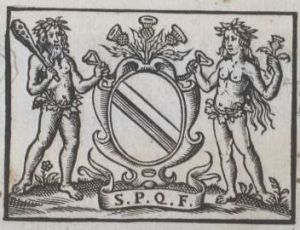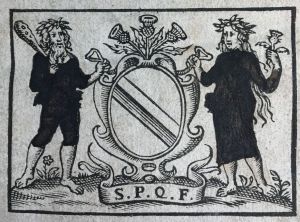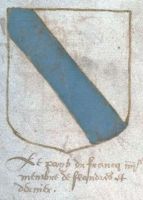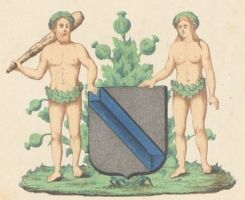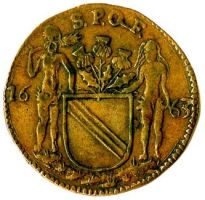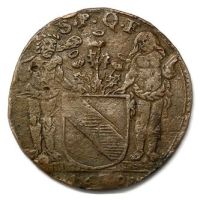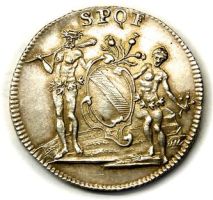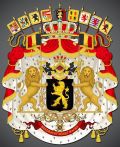Vrije van Brugge: Difference between revisions
Knorrepoes (talk | contribs) |
Knorrepoes (talk | contribs) No edit summary |
||
| (5 intermediate revisions by the same user not shown) | |||
| Line 1: | Line 1: | ||
''' {{uc:{{PAGENAME}} / Brugse Vrije}} ''' | ''' {{uc:{{PAGENAME}} / Brugse Vrije}} ''' | ||
| Line 14: | Line 12: | ||
The arms show a blue bend sinister in a silver field. The meaning thereof is not known. As supporters two savages were used. The arms have been used as such since at least the early 17th century. | The arms show a blue bend sinister in a silver field. The meaning thereof is not known. As supporters two savages were used. The arms have been used as such since at least the early 17th century. | ||
When in the 17th century the Northernmost part of Flanders became Dutch (the Southern part remained under Spanish control), the Dutch part of the Brugse Vrije was separated as the Vrije van Sluis, which used the same arms until the end of the 18th century. | When in the 17th century the Northernmost part of Flanders became Dutch (the Southern part remained under Spanish control), the Dutch part of the Brugse Vrije was separated as the Vrije van Sluis, which used the same arms (but different supporters, see [[Groede]]) until the end of the 18th century. | ||
Many villages in Belgium and the Netherlands used the bend or the complete arms of the Vrije when granted arms in the early 19th century. See [[Klerken]], [[Koolkerke]], [[Stene]], [[Cadzand]], [[Groede]], [[Oostburg]] and many more. | Many villages in Belgium and the Netherlands used the bend or the complete arms of the Vrije when granted arms in the early 19th century. See [[Klerken]], [[Koolkerke]], [[Stene]], [[Cadzand]], [[Groede]], [[Oostburg]] and many more. | ||
| Line 25: | Line 23: | ||
===Image gallery=== | |||
<gallery widths=250px heights=200px perrow=0> | <gallery widths=250px heights=200px perrow=0> | ||
File:Vrije van Brugge1558.jpg|alt=Wapen van Vrije van Brugge/Arms (crest) of Vrije van Brugge|The arms in a manuscript from 1558 | |||
File:vrije1862.jpg|alt=Wapen van het Vrije van Brugge/Arms (crest) of Vrije van Brugge|The arms in a 17th century [https://bm-lille.fr/patrimoine/digital-viewer/c-16435 manuscript] | File:vrije1862.jpg|alt=Wapen van het Vrije van Brugge/Arms (crest) of Vrije van Brugge|The arms in a 17th century [https://bm-lille.fr/patrimoine/digital-viewer/c-16435 manuscript] | ||
File:vrijec.jpg|alt=Wapen van /Arms (crest) of |The arms on a local token from 1663 | |||
File:vrijec1.jpg|alt=Wapen van /Arms (crest) of |The arms on a local token from 1670 | |||
File:vrijec2.jpg|alt=Wapen van /Arms (crest) of |The arms on a local token from 1755 | |||
</gallery> | </gallery> | ||
| Line 33: | Line 36: | ||
[[Literature]]: | [[Literature]]: | ||
{{ | {{be}} | ||
{{media}} | {{media}} | ||
[[Category:Belgium]] | [[Category:Belgium]] | ||
Latest revision as of 13:19, 26 February 2024
VRIJE VAN BRUGGE / BRUGSE VRIJE
Official blazon
Origin/meaning
Unfortunately we have no information on the meaning or origin of these arms yet.
If you have any information on the origin or meaning of these arms, or have additional images that you want to share, please mail us your information !
The Brugse Vrije was a castellany in the county of Flanders; it included the area around Brugge, and was bordered by the North Sea, the Westerschelde and the IJzer river. The city of Brugge was separated from the castellany in 1127. Since then the city and the Vrije were considered as separate customary law areas. The Brugse Vrije was a rich agricultural region. It had its own burgrave, who was seated at the Burg, a square in Brugge, and became part of the Four Members of Flanders at the end of the 14th century, together with the three major cities of Gent, Brugge and Ieper. The Brugse Vrije sat in the meetings of the States of Flanders.
The arms show a blue bend sinister in a silver field. The meaning thereof is not known. As supporters two savages were used. The arms have been used as such since at least the early 17th century.
When in the 17th century the Northernmost part of Flanders became Dutch (the Southern part remained under Spanish control), the Dutch part of the Brugse Vrije was separated as the Vrije van Sluis, which used the same arms (but different supporters, see Groede) until the end of the 18th century.
Many villages in Belgium and the Netherlands used the bend or the complete arms of the Vrije when granted arms in the early 19th century. See Klerken, Koolkerke, Stene, Cadzand, Groede, Oostburg and many more.
Two images of the arms of the Vrije from 1646 on publications/[pamphlets (one rather censored !):
Image gallery
The arms in a 17th century manuscript
Belgium heraldry portal
This page is part of the Belgium heraldry portal |
Heraldry of the World |
|
Civic heraldry:
|
Other heraldry: |
Contact and Support
Partners:
Your logo here ?
Contact us
© since 1995, Heraldry of the World, Ralf Hartemink 
Index of the site

